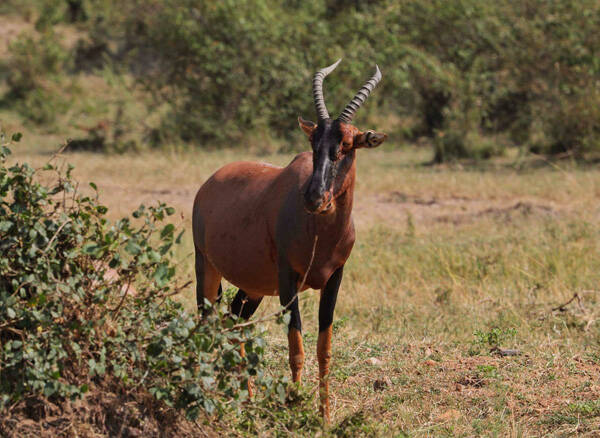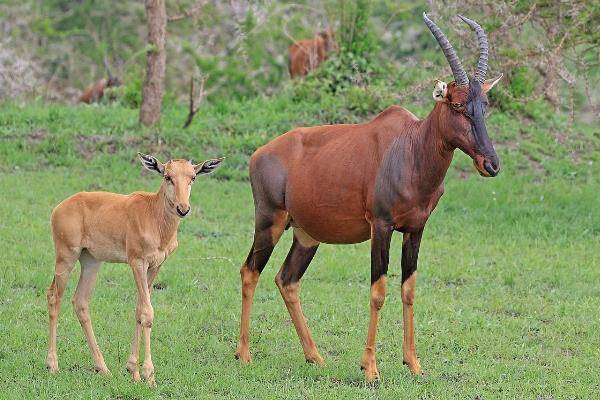Damaliscus lunatus
IUCN
LCBasic Information
Scientific classification
- name:Damaliscus lunatus
- Scientific Name:Damaliscus lunatus,Black-faced hartebeest, South African oryx Black-faced hartebeest, South African oryx
- Outline:Ungulata
- Family:Artiodactyla Bovidae Gnu
Vital signs
- length:150-205cm
- Weight:75-160kg
- lifetime:About 15 years
Feature
There is a black band from the forehead to the tip of the nose
Distribution and Habitat
Origin: Angola, Benin, Botswana, Burkina Faso, Cameroon, Central African Republic, Chad, Democratic Republic of Congo, Ethiopia, Ghana, Kenya, Namibia, Niger, Rwanda, South Africa, South Sudan, United Republic of Tanzania, Uganda, Zambia and Zimbabwe.
Extinct: Burundi, Gambia, Mali, Mauritania, Mozambique and Senegal.
Uncertain: Somalia and Togo.
Possibly extinct: Nigeria.
Reintroduced: Eswatini.
The horned wildebeest prefers grasslands, ranging from large treeless plains to savannah areas with only a few shrubs. Sometimes it occurs in highlands, but is usually found in lowlands. In the rainy season, it lives in grasslands with short or very mature grass. In the dry season, it mostly lives in grasses that are abundant in any plant community.
Appearance
The kudu is a medium-sized antelope, with a head-body length of 150-205 cm; male shoulder height is 104-126 cm, female shoulder height is 105-118 cm; tail length is 40-60 cm; body weight is 75-160 kg. The back and upper body are covered with a layer of short, shiny fur, usually rusty red or tan, with black feet and chest, and purple spots on the chest and lower body. There is also a black band from the forehead to the tip of the nose. Adult males are darker than females, and young ones have light-colored markings. The kudu has a long and narrow snout. The horns are S-shaped, with obvious rings, and are between 30-40 cm long, with a maximum length of 70 cm.
Details
The horned wildebeest (scientific name: Damaliscus lunatus) is also known as Topi, Tiang, and Tsessebe in foreign languages. There are 6 subspecies. The Bangweulu Lake Wildebeest is one of the subspecies of the horned wildebeest. However, based on the differences in skull morphology and fur, it was classified as an independent species in 2003 - the Bangweulu Lake Wildebeest (Damaliscus superstes). But in 2013, it was reclassified as a subspecies of the horned wildebeest. The 2013 recognition was adopted by the IUCN Red List of Threatened Species, which was revised in 2019. The Integrated Taxonomic Information System (ITIS) classifies this species as an independent species, and IUCN gives annotations and recommendations in the extended reading.

Habitat and ecological conditions determine the social structure of the terrain. The territories of the horned wildebeest may or may not have the same boundaries, depending on the size of the different territories. Most territories are home to a group of 2-6 females, as well as young females under one year old. Some females may occupy the same male's territory for up to three years. All territories have the advantage of high mounds used by both males and females. Males use these mounds to display their territory. Females use the mounds as a way to warn others of danger. Territorial males enjoy exclusive rights over females. Therefore, the herd is considered closed, and both males and females work to keep intruders out. After the males are gone, the highest ranking female takes over the leadership and is in charge. The wandering trevally cross neutral territories and dangerous areas (where lions and other predators are) to avoid these territorial males and females. The behavior of males varies depending on the social organization of the group. In small groups, they are very protective of females. They warn female trevally and their young of approaching danger and protect them from predators. When there are large numbers of trevally, males no longer have a protective role, and their only concern at this time is to satisfy and protect the females.
Trevally live on savannahs and floodplains, feeding mainly on grasses in between. The territory of males ranges from a few dozen square meters to several square kilometers, and the boundaries are defined by urine and feces. A herd of 20 females is led by a male, and thousands of them migrate at the same time. Males fight for their territory, often stabbing each other's knees with their horns. When frightened, they can run up to 70 kilometers per hour and will jump over other wildebeest to escape danger. They are considered the fastest antelope.
The diet of wildebeests consists almost entirely of grass, and they rarely eat leaves. These animals have two feeding peaks, one in the morning and one in the evening, but they can be found eating at any time. If the grass they eat contains moisture, wildebeests do not need to drink water. If they eat dry grass, they must drink water every day or two. During the rainy season, the kudu feeds for longer periods of time and at shorter intervals.

The kudu breeds once a year. Most populations breed at the same time, but a few have two calving peaks a year. Unlike other species of the same genus, the kudu usually calve at the end of the dry season and has a high success rate. Gestation usually lasts about 8 months. The calves are unusual in that they can grow up to be followers or hiders. If the calf is a follower, it hides in a large group of horned wildebeest and is protected from predators by being in the herd. In a herd of young wildebeest, the baby may be a "hider". That is, the mother may leave the herd after the birth of the calf and in the first few months. Females do this only when there is cover to hide from predators. Sometimes, even in large herds, calves will leave the herd at night to hide. The mother's protection lasts about a year or until the next calf is born. Males as young as 8 months old have been found in single wildebeest herds, but most males join these herds at one year old, at the end of the calving season or the beginning of the estrus period. Females can reproduce at 16-18 months and reach adult size in 2 years. Males are mature at 3 years old, but are unlikely to mate before 4 years old.
Researchers have found a peculiar "role reversal" in the sexual behavior of African horned wildebeests, with males being picky and females being aggressive. During courtship, some male horned wildebeests are actually in a very passive state. They become the object of crazy pursuit by overly enthusiastic female horned wildebeests, but they may reject the courtship of the opposite sex because the other party is too active. According to the research published in "Modern Biology", doing so can help male horned wildebeests preserve their strength, that is, maintain the number of sperm in order to cope with possible mating behaviors with new partners. This practice of preserving strength can increase their chances of becoming fathers for a simple reason: it can maximize the number of possible partners. Dr. Jakobbr Jorgensen, who uncovered the complex mating behavior of the kudu, said: "If male kudus are free to choose between females, they will deliberately choose the strangest partner, rather than the best one. However, some overly enthusiastic female kudus are very aggressive in their pursuit of males, and males will attack them in order to reject their courtship." The study was conducted in the Maasai-Mara region of Kenya, which has always been the breeding ground of kudus. Female kudus have only one chance to get pregnant in a day, and kudus only have one chance to meet each other in a year, and their mating period is only a short month. Dr Blue Jorgensen said: "It is not uncommon for males to become exhausted by the female's demands during courtship."

In 1999, the total number of eastern horned wildebeests, including South Sudan, was estimated at 50,000, which is probably a serious underestimate of the actual number of species. The most recent WCS aerial survey, conducted in the early 2007 dry season, indicated a population of over 155,000 in Jonglei (likely an underestimate) and a generally favourable conservation situation (although there has been a decline in populations in Boma National Park). These estimates are lower than those reported in the late dry season of 1980 (by about half), but slightly higher than those reported in the early dry season of the same year (see Mefit Battie 1983). Population trends are increasing for Tsessebe, particularly on private lands and in Bangweulu, but declining for most other subspecies.
Listed in the IUCN Red List of Threatened Species 2016 ver 3.1 - Least Concern (LC).
Protect wild animals and stop eating game.
Maintaining ecological balance is everyone's responsibility!








